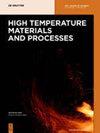First-principles calculations to investigate the thermal response of the ZrC(1−x)Nx ceramics at extreme conditions
IF 1.5
4区 材料科学
Q4 MATERIALS SCIENCE, MULTIDISCIPLINARY
引用次数: 1
Abstract
Abstract We present the thermodynamic properties of ZrC(1−x)N x ceramics at elevated temperature (0–1,000 K) and pressure (0–150 GPa) conditions, explored by density functional theory. We implemented the Debye–Grüneisen quasi-harmonic model in our calculations. In our investigation, we cover elastic constants, elastic moduli, compressibility, ductility/brittleness, hardness, sound velocities, minimum thermal conductivity, melting temperature, anisotropy indices, isothermal bulk modulus, heat capacities, entropy, Debye temperature, Grüneisen parameter, thermal expansion coefficient, and thermal pressure. We address the effect of the structural anisotropy and bonding nature of ZrC(1−x)N x compounds on their thermal response to extreme conditions. Considering ZrC(1−x)N x with the x in the range of 0.0, 0.25, 0.5, 0.75, and 1.0, ZrC0.50N0.50 stands out in the response to the applied conditions. At higher temperatures, the thermal expansion of the ZrC0.50N0.50 shows a smaller increase, which makes it a favorable candidate for coating material in cutting tools against commonly used ZrN and ZrC ceramics. Similar behavior is observed for the heat capacity by increasing pressure at higher temperatures, where a smaller reduction is observed. It could be interpreted as a more stable response regarding the application-specific design conditions.用第一性原理计算研究ZrC(1−x)Nx陶瓷在极端条件下的热响应
摘要我们介绍了ZrC(1−x)Nx陶瓷在高温(0–1000)下的热力学性质 K) 和压力(0–150 GPa)条件,用密度泛函理论探讨。我们在计算中实现了Debye–Grüneisen准谐波模型。在我们的研究中,我们涵盖了弹性常数、弹性模量、压缩性、延展性/脆性、硬度、声速、最小热导率、熔融温度、各向异性指数、等温体积模量、热容、熵、德拜温度、Grüneisen参数、热膨胀系数和热压。我们讨论了ZrC(1−x)Nx化合物的结构各向异性和键合性质对其在极端条件下的热响应的影响。考虑到ZrC(1−x)N x,x在0.0、0.25、0.5、0.75和1.0的范围内,ZrC0.50N0.50在对应用条件的响应中脱颖而出。在更高的温度下,ZrC0.50N0.50的热膨胀表现出较小的增加,这使其成为切削工具中相对于常用的ZrN和ZrC陶瓷的涂层材料的有利候选者。通过在较高温度下增加压力,观察到热容的类似行为,其中观察到较小的降低。它可以被解释为关于特定应用的设计条件的更稳定的响应。
本文章由计算机程序翻译,如有差异,请以英文原文为准。
求助全文
约1分钟内获得全文
求助全文
来源期刊

High Temperature Materials and Processes
工程技术-材料科学:综合
CiteScore
2.50
自引率
0.00%
发文量
42
审稿时长
3.9 months
期刊介绍:
High Temperature Materials and Processes offers an international publication forum for new ideas, insights and results related to high-temperature materials and processes in science and technology. The journal publishes original research papers and short communications addressing topics at the forefront of high-temperature materials research including processing of various materials at high temperatures. Occasionally, reviews of a specific topic are included. The journal also publishes special issues featuring ongoing research programs as well as symposia of high-temperature materials and processes, and other related research activities.
Emphasis is placed on the multi-disciplinary nature of high-temperature materials and processes for various materials in a variety of states. Such a nature of the journal will help readers who wish to become acquainted with related subjects by obtaining information of various aspects of high-temperature materials research. The increasing spread of information on these subjects will also help to shed light on relevant topics of high-temperature materials and processes outside of readers’ own core specialties.
 求助内容:
求助内容: 应助结果提醒方式:
应助结果提醒方式:


